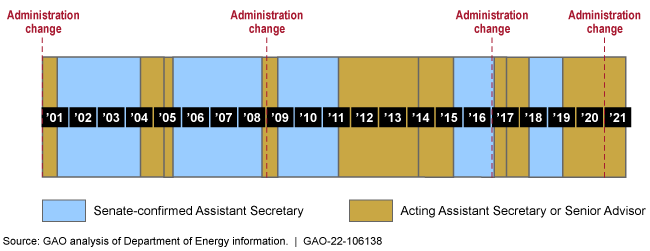Nuclear Waste Cleanup: Enhanced Coordination, Prioritization, and Leadership Commitment Could Improve DOE Research and Development Efforts
Fast Facts
The Department of Energy has been cleaning up massive amounts of hazardous and radioactive waste from decades of nuclear weapons production and energy research. DOE's research and development has improved its cleanup efforts through safer and more efficient approaches.
We found:
- Ways that DOE could better coordinate and prioritize cleanup R&D
- Leadership challenges at DOE, including frequent turnover that has shifted agency actions away from long-term cleanup priorities
We testified that implementing our prior recommendations would help ensure DOE's progress on its crucial cleanup mission.
Turnover in the Office of Environmental Management's Top Leadership Position, 2001 to 2021

Highlights
What GAO Found
The Department of Energy's (DOE) Office of Environmental Management (EM) coordinates research and development (R&D) related to nuclear waste cleanup across the EM complex—EM headquarters, its 15 sites, and the 11 DOE national laboratories that conduct R&D related to nuclear cleanup. EM's coordination of R&D efforts, which include ways to improve worker safety, such as by using robotics (see fig.), fully aligns with four of GAO's seven leading practices for collaboration. However, EM does not fully follow other leading practices, which affects its ability to evaluate the effectiveness of R&D efforts. For example, EM officials told GAO that EM does not have a formal system to collect information on R&D activities across the complex, which would enable it to monitor and evaluate the activities' outcomes. Collecting such information could help EM determine whether to encourage or discourage investments in certain areas.
Robotic Technologies Potentially Applicable to Department of Energy Nuclear Cleanup Efforts

EM also does not take a comprehensive approach to prioritizing R&D. Individual EM sites and national laboratories have their own decision-making processes for prioritizing R&D, but these may not address long-term or complex-wide needs. GAO has found that risk-informed decision-making can help agencies weigh numerous factors and consider trade-offs and that doing so would help EM set cleanup priorities within and across its sites. By developing a comprehensive, risk-informed approach, EM would be better positioned to provide sites with guidance for R&D spending beyond their immediate operational needs and to direct its limited R&D resources to its highest priorities.
GAO identified opportunities to strengthen DOE's leadership commitment to the cleanup mission, which may also enhance the effectiveness of its R&D efforts. For example, EM has experienced frequent turnover in its top leadership position. Legislation establishing a term appointment for this position could help improve stability, address challenges, and better support EM's long-term mission. In addition, DOE's organizational structure has not provided sustained leadership commitment for addressing environmental cleanup. A new, dedicated DOE under secretary position for nuclear waste management and environmental cleanup could help ensure that EM receives the sustained attention and commitment it needs to make cleanup progress.
Why GAO Did This Study
R&D has played an essential role in EM's efforts to clean up contamination from decades of nuclear weapons production and energy research. Such R&D has led to safer, more efficient, and more effective cleanup approaches. Prior studies have found that investments in R&D could reduce the future costs of EM's cleanup efforts. These costs have increased by nearly $250 billion in the last 10 years and are included on GAO's High Risk List. However, funding designated for nuclear cleanup R&D has declined since 2000.
This testimony discusses the extent to which EM (1) coordinates R&D across the EM complex, (2) prioritizes cleanup-related R&D efforts, and (3) has had sustained and consistent leadership commitment. For the October 2021 and May 2022 reports on which this testimony is based, GAO reviewed DOE documents and compared EM's R&D coordination efforts with leading practices. GAO also interviewed EM and national laboratory officials and former EM leaders.
Recommendations
In its October 2021 report , GAO made four recommendations, including that DOE develop (1) a system to collect R&D information across the complex and (2) a comprehensive approach to prioritizing R&D. DOE concurred with both recommendations and is considering how best to implement them. In its May 2022 report, GAO recommended two matters for congressional consideration, including establishing a term appointment for EM's top leader and creating a new DOE under secretary position.
